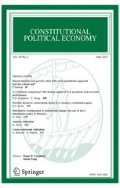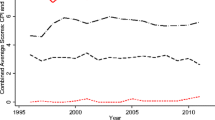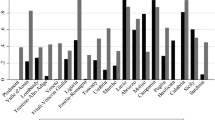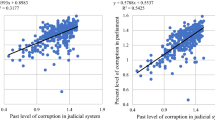Abstract
Just as its constitutional development is characterised by frequent change and substantial concentration of power, the Latin American and the Caribbean area is known to host some of the most corrupt countries of the world. A group of countries such as Chile, Barbados and Uruguay, however, report levels of corruption similar to those displayed by most European countries. We ask whether the concentration of power in the executive, as well as in the national parliament in this particular region, affect how corrupt a society is. Using panel data from 22 Latin America and Caribbean countries from 1970 to 2014, we find that constitutional power concentration is in fact a determinant of corruption. Yet, the constitutional provisions allocating powers of government appear only to be consistently important when parliament is ideologically fractionalised.


Similar content being viewed by others
Notes
While European countries and the European offspring do occasionally implement constitutional amendments, they are much rarer than in Latin America. According to data in Elkins et al. (200), only 20 percent of all countries in Western Europe or similarly rich countries in North America and Australasia introduced a new constitution between 1970 and 2014. The average number of amendments in these countries during the same period was 12, and exploring these amendments, it is clear that most aim at defining existing constitutional rights more precisely. These numbers are dwarfed by, e.g., the 92 amendments to the Brazilian constitution since its implementation in 1988, the on average annual amendments to the constitution of Mexico, and the three new constitutions in the Dominican Republic since 1970. The typical country in Latin America and the Caribbean has implemented a new constitution every 15th year since 1950, making such implementation 11 times as likely as in Western countries.
Latin America and the Caribbean is distinct from Europe and the European offspring by having substantially more constitutional change. However, so is Africa and parts of Asia where Thailand for example has implemented 15 new constitutions since 1945. We nevertheless refrain from using data from other parts of the developing world, as African and Asian constitutional development is often characterised by the use of interim constitutions and the comparatively frequent cancellation of the constitution. By focusing exclusively on Latin America and the Caribbean, we thus avoid the problem of how to deal with the phenomenon of constitutional limbo.
In a large number of cases, all observations in the CCP are missing following constitutional amendments that were not coded. The data then reappear after either a new constitution is implemented or a major amendment is coded by the CCP team. We have filled in these missing values by reading all amendments in between observations and coding any changes within the amendments that concern the 14 provisions entering either index.
While the V-Dem dataset is quite comprehensive, it unfortunately does not include a number of the smaller countries in Latin America and the Caribbean. As such, even though our constitutional data are available for, e.g., the Bahamas, Belize and Saint Vincent and the Grenadines, we cannot include these countries due to a lack of data on our outcome variables.
We also provide first indications of the association between corruption and the direction of the constitutional reforms in Figures A2 and A3 in the appendix, where we plot the association between the average corruption between 1970 and 2014 and the IPLI and EIE respectably. As the figures illustrate, the correlation between corruption and the IPLI and IEI are far from homogeneous.
Although we find significant effects of bicameral studies, we must warn against concluding too much on this basis. Because of the presence of country fixed effects, the effects are identified by a very small number of changes.
The PolCon index is in principle distributed between 0 and 1 although scores above .7 are rare. The index is composed of constitutionally defined veto structures, but corrected for whether actors within these structures are politically aligned or not. In perfectly unconstrained autocracies, the index is zero while we do observe some democracies with low scores, as potential veto players – upper chambers, high courts etc. – are politically aligned with the incumbent government. Within our sample, Colombia and El Salvador in the early 2000 s fall into this category.
References
Acemoglu, D., Johnson, S., & Robinson, J. A. (2001). The colonial origins of comparative development: An empirical investigation. American Economic Review, 91, 1369–1401.
Acemoglu, D., Robinson, J. A., & Torvik, R. (2013). Why do voters dismantle checks and balances? Review of Economic Studies, 80, 845–875.
Ades, A., & Di Tella, R. (1999). Rents, competition, and corruption. American Economic Review, 89(4), 982–993.
Aghion, P., Alesina, A., & Trebbi, F. (2004). Endogenous political institutions. Quarterly Journal of Economics, 119, 565–611.
Aidt, T. (2003). Analysis of corruption: A survey. The Economic Journal, 113, F632–F652.
Aidt, T. (2019). Corruption. In R. Congleton, B. Grofmann, & S. Voigt (Eds.), Oxford handbook of public choice (Vol. II, pp. 604–627). Oxford: Oxford University Press.
Banfield, E. C. (1975). Corruption as a feature of governmental organization. Journal of Law and Economics, 18, 587–605.
Becker, G. (1968). Crime and punishment: An economic approach. Journal of Political Economy, 76, 169–217.
Berggren, N., & Bjørnskov, C. (2017). The market-promoting and market-preserving role of social trust in reforms of policies and institutions. Southern Economic Journal, 84, 3–25.
Bjørnskov, C., & Freytag, A. (2016). An offer you can’t refuse: Murdering journalists as an enforcement mechanism of corrupt deals. Public Choice, 167, 221–243.
Bjørnskov, C., & Rode, M. (2020). Regimes and regime transitions: a new dataset on democracy, coups, and political institutions. Review of International Organizations, 15, 531–551.
Bjørnskov, C., & Voigt, S. (2018). Why do governments call a state of emergency? On the determinants of using emergency constitutions. European Journal of Political Economy, 54, 110–123.
Brambor, T., Clark, W., & Golder, M. (2006). Understanding interaction models: Improving empirical analyses. Political Analysis, 14, 63–82.
Brennan, G., & Buchanan, J. M. (1985). The reason of rules. Constitutional political economy. Cambridge: Cambridge University Press.
Buchanan, J. M. (1975). A contractarian paradigm for applying economic theory. American Economic Review, Papers & Proceedings, 55, 225–230.
Buchanan, J. M., & Tullock, G. (1962). The calculus of consent. Ann Arbor: University of Michigan Press.
Cheibub, J. A., Gandhi, J., & Vreeland, J. R. (2010). Democracy and dictatorship revisited. Public Choice, 143, 67–101.
Congleton, R. D. (2019). The political economy of rent creation and rent extraction. In R. Congleton, B. Grofmann, & S. Voigt (Eds.), Oxford handbook of public choice (Vol. I, pp. 604–627). Oxford: Oxford University Press.
Coppedge, M., Lindberg, S., Skaaning, S.-E., & Teorell, J. (2016). Measuring high level democratic principles using the V-Dem data. International Political Science Review, 37, 580–593.
Diermeier, D., & Myerson, R. B. (1999). Bicameralism and its consequences for the internal organization of legislatures. American Economic Review, 89, 1182–1196.
Dreher, A., Gaston, N., & Martens, P. (2008). Measuring globalization: Gauging its consequences. New York: Springer.
Elkins, Z., Ginsburg, T., & Melton, J. (2009). The endurance of national constitutions. Cambridge: Cambridge University Press.
Feenstra, R. C., Inklaar, R., & Timmer, M. P. (2015). The next generation of the Penn world table. American Economic Review, 105, 3150–3182.
Feld, L., & Voigt, S. (2003). Economic growth and judicial independence: Cross-country evidence using a new set of indicators. European Journal of Political Economy, 19, 497–527.
Foldvari, P. (2017). De facto versus de jure political institutions in the long-run: a multivariate analysis, 1820–2000. Social Indicators Research, 130, 759–777.
Gatti, R. (1999). Corruption and trade tariffs, or a case for uniform tariffs. World Bank Policy Research Working Paper no. 2216, the World Bank, Washington, DC.
Gerring, J., & Thacker, S. C. (2004). Political institutions and corruption: The role of unitarism and parliamentarism. British Journal of Political Science, 34, 295–330.
Ginsburg, T., & Melton, J. (2014). Does de jure judicial independence really matter? A reevaluation of explanations for judicial independence. Journal of Law and Courts, 2, 187–217.
Gupta, S., Davoodi, H., & Alonso-Terme, R. (2002). Does corruption affect income inequality and poverty? Economics of Governance, 3, 23–45.
Henisz, W. (2002). The institutional environment for infrastructure investment. Industrial and Corporate Change, 11, 355–389.
Henisz, W. (2017). The Political Constraint Index (POLCON) Dataset. Database and codebook, Accessed July, 2018 from, https://mgmt.wharton.upenn.edu/faculty/heniszpolcon/polcondataset/.
Hilbink, L. (2007). Judges beyond politics in democracy and dictatorship. Lessons from Chile. Cambridge: Cambridge University Press.
Klitgaard, R. (1988). Controlling corruption. Berkeley: University of California Press.
Knack, S. (2007). Measuring corruption: A critique of indicators in Eastern Europe and Central Asia. J Public Policy, 27, 255–291.
Montinola, G. R., & Jackman, R. W. (2002). Sources of corruption: A cross-country study. British Journal of Political Science, 32, 147–170.
Negretto, G. L. (2014). Making constitutions: presidents, parties, and institutional choice in Latin America. Cambridge: Cambridge University Press.
Nizalova, O. Y., & Murtazashvili, I. (2016). Exogenous treatment and endogenous factors: Vanishing of omitted variable bias on the interaction term. Journal of Econometric Methods, 5, 71–77.
Ordeshook, P. C. (1992). Constitutional stability. Constitutional Political Economy, 3, 137–175.
Padovano, F., Sgarra, G., & Fiorino, N. (2003). Judicial branch, checks and balances and political accountability. Constitutional Political Economy, 14, 47–70.
Persson, T. (2002). Do political institutions shape economic policy? Econometrica, 70(3), 883–905.
Poole, K. T., & Rosenthal, H. L. (2011). Ideology and congress. London: Routledge.
Rose-Ackerman, S. (1999). Corruption and government, causes, consequences. Cambridge: Cambridge University Press.
Salzberger, E. M. (1993). A positive analysis of the doctrine of separation of powers, or: why do have an independent judiciary? Int Rev Law Econ, 13, 349–379.
Treisman, D. (2002). The causes of corruption: a cross-national study. J Public Econ, 76, 399–457.
Treisman, D. (2007). What have we learned about the causes of corruption from ten years of cross-National empirical research? Annual Review of Political Science, 10, 211–244.
Tullock, G. (1981). Why so much stability? Public Choice, 37, 189–204.
Uslaner, E. M., & Davis, R. (1975). The paradox of vote trading: Effects of decision rules and voting strategies on externalities. American Political Science Review, 69, 929–942.
Versteeg, M., & Zackin, E. (2016). Constitutions unentrenched: Toward an alternative theory of constitutional design. American Political Science Review, 110, 657–674.
Voigt, S. (2013). How (not) to measure institutions. Journal of Institutional Economics, 9, 1–26.
World Bank. (2001). The World Bank annual report 2001: Year in review (English). Washington: World Bank.
Acknowledgements
We thank Roger Congleton, Peter Lewisch, Christoph Moser, Martin Rode, Paul Schaudt, Stefan Voigt, participants at the 2019 Danish Public Choice Workshop (Aarhus), the 2019 meetings of the European Public Choice Society (Jerusalem), the 2019 Beyond Basic Questions workshop (Kiel), and the 2019 conference of the European Association of Law and Economics (Tel Aviv), as well as two anonymous reviewers at this journal for helpful comments on earlier versions. Bjørnskov gratefully acknowledges financial support from the Jan Wallander and Tom Hedelius Foundation. Sáenz de Viteri would like to acknowledge the Asociación de Amigos de la Universidad de Navarra and Banco Santander for their financial support. Any remaining errors are of course entirely ours.
Author information
Authors and Affiliations
Corresponding author
Additional information
Publisher's Note
Springer Nature remains neutral with regard to jurisdictional claims in published maps and institutional affiliations.
Rights and permissions
About this article
Cite this article
de Viteri Vázquez, A.S., Bjørnskov, C. Constitutional power concentration and corruption: evidence from Latin America and the Caribbean. Const Polit Econ 31, 509–536 (2020). https://doi.org/10.1007/s10602-020-09317-3
Published:
Issue Date:
DOI: https://doi.org/10.1007/s10602-020-09317-3








